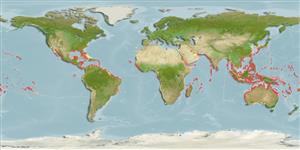>
Beloniformes (Needle fishes) >
Exocoetidae (Flyingfishes)
Etymology: Parexocoetus: Greek, para in the side of + Greek, exos = outside + Greek, koite = hole (Ref. 45335).
More on author: Richardson.
Environment: milieu / climate zone / depth range / distribution range
Ekologi
laut; oceanodromus (Ref. 51243); kisaran kedalaman 0 - 20 m. Subtropical; 37°N - 35°S, 34°E -
Indo-Pacific: widespread from East Africa, including the Red Sea (Ref. 26165) to southern Japan, Hawaii, the Marquesas, and Queensland (Australia); separate population in the eastern tropical Pacific (Bay of Panama). Western Atlantic: northeastern Florida, USA and the Bahamas to Brazil (Ref. 7251); common in Caribbean Sea and Lesser Antilles area; less common in the Gulf of Mexico, the Gulf Stream and the western Sargasso Sea (Ref. 3720). Eastern Atlantic: Guinea to Angola (Ref. 4498).
Length at first maturity / Size / Weight / umur
Maturity: Lm 12.0, range 11 - 13 cm
Max length : 20.0 cm TL jantan/; (Ref. 5217); common length : 16.0 cm TL jantan/; (Ref. 5217)
Duri punggung (Keseluruhan (total)): 0; duri punggung lunak (Keseluruhan (total)): 12-14; Duri dubur 0; Sirip dubur lunak: 12 - 14. Body iridescent greenish blue dorsally, silvery white ventrally; dorsal black except for base and posterior rays which are pale; pelvic fins greyish, other fins transparent (Ref. 2797).
Occurs in coastal waters (Ref. 9300), rare in the open ocean (Ref. 9839). Capable of leaping out of the water and gliding for considerable distances above the surface. 3-4 individuals aggregate during breeding (Ref. 47825). Carnivorous (Ref. 9137). Not important as food fish, but occasionally taken by fisheries.
During breeding, a spawning aggregation composed at least of 3-4 individuals, probably 2-3 males to 1 female, were observed jumping and flying over the water surface, exuding ripe eggs and sperm in the process.
Spawning on surface substrate (e.g. flotsam) when present is the usual reproductive mode but other modes may be employed if this substrate is not available. The fertilised eggs may remain suspended in the water surface during its development with the help of the small filaments on the egg surface and the adhesive filaments holding the egg mass together, by increasing the surface to volume ratio of the eggs, which aids in propping the eggs up in the water column. The eggs may also be suspended upon current or become benthic.
Parin, N.V., 1996. On the species composition of flying fishes (Exocoetidae) in the West-Central part of tropical Pacific. J. Ichthyol. 36(5):357-364. (Ref. 27313)
Status IUCN Red List (Ref. 130435)
ancaman kepada manusia
Harmless
penggunaan manusia
Perikanan: nilai komersial kecil
informasi lanjut
AcuanBudidaya airprofil budidaya airStrainGenetikaElectrophoresesDiturunkanPenyakit-penyakitPengolahanNutrientsMass conversion
Alat, peralatan
laporan khas
muat turun XML
Sumber internet
Estimates based on models
Preferred temperature (Ref.
123201): 23.3 - 29.2, mean 27.8 °C (based on 4764 cells).
Phylogenetic diversity index (Ref.
82804): PD
50 = 0.6250 [Uniqueness, from 0.5 = low to 2.0 = high].
Bayesian length-weight: a=0.00646 (0.00292 - 0.01429), b=3.04 (2.84 - 3.24), in cm total length, based on LWR estimates for this (Sub)family-body shape (Ref.
93245).
Trophic level (Ref.
69278): 3.4 ±0.45 se; based on food items.
Daya lenting (Ref.
120179): Tinggi, Waktu penggandaan populasi minimum kurang dari 15 bulan (Preliminary K or Fecundity.).
Fishing Vulnerability (Ref.
59153): Low vulnerability (10 of 100).
Nutrients (Ref.
124155): Calcium = 479 [160, 1,136] mg/100g; Iron = 3.29 [1.39, 7.43] mg/100g; Protein = 17.6 [15.4, 19.7] %; Omega3 = 0.339 [0.115, 1.121] g/100g; Selenium = 32.4 [11.1, 88.9] μg/100g; VitaminA = 9 [2, 49] μg/100g; Zinc = 1.45 [0.85, 2.51] mg/100g (wet weight);
